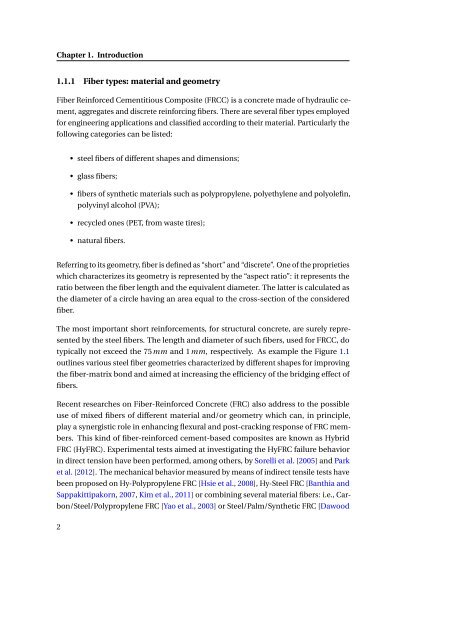tesi A. Caggiano.pdf - EleA@UniSA - Università degli Studi di Salerno
tesi A. Caggiano.pdf - EleA@UniSA - Università degli Studi di Salerno
tesi A. Caggiano.pdf - EleA@UniSA - Università degli Studi di Salerno
- No tags were found...
Create successful ePaper yourself
Turn your PDF publications into a flip-book with our unique Google optimized e-Paper software.
Chapter 1. Introduction1.1.1 Fiber types: material and geometryFiber Reinforced Cementitious Composite (FRCC) is a concrete made of hydraulic cement,aggregates and <strong>di</strong>screte reinforcing fibers. There are several fiber types employedfor engineering applications and classified accor<strong>di</strong>ng to their material. Particularly thefollowing categories can be listed:• steel fibers of <strong>di</strong>fferent shapes and <strong>di</strong>mensions;• glass fibers;• fibers of synthetic materials such as polypropylene, polyethylene and polyolefin,polyvinyl alcohol (PVA);• recycled ones (PET, from waste tires);• natural fibers.Referring to its geometry, fiber is defined as “short” and “<strong>di</strong>screte”. One of the proprietieswhich characterizes its geometry is represented by the “aspect ratio”: it represents theratio between the fiber length and the equivalent <strong>di</strong>ameter. The latter is calculated asthe <strong>di</strong>ameter of a circle having an area equal to the cross-section of the consideredfiber.The most important short reinforcements, for structural concrete, are surely representedby the steel fibers. The length and <strong>di</strong>ameter of such fibers, used for FRCC, dotypically not exceed the 75mm and 1mm, respectively. As example the Figure 1.1outlines various steel fiber geometries characterized by <strong>di</strong>fferent shapes for improvingthe fiber-matrix bond and aimed at increasing the efficiency of the bridging effect offibers.Recent researches on Fiber-Reinforced Concrete (FRC) also address to the possibleuse of mixed fibers of <strong>di</strong>fferent material and/or geometry which can, in principle,play a synergistic role in enhancing flexural and post-cracking response of FRC members.This kind of fiber-reinforced cement-based composites are known as HybridFRC (HyFRC). Experimental tests aimed at investigating the HyFRC failure behaviorin <strong>di</strong>rect tension have been performed, among others, by Sorelli et al. [2005] and Parket al. [2012]. The mechanical behavior measured by means of in<strong>di</strong>rect tensile tests havebeen proposed on Hy-Polypropylene FRC [Hsie et al., 2008], Hy-Steel FRC [Banthia andSappakittipakorn, 2007, Kim et al., 2011] or combining several material fibers: i.e., Carbon/Steel/PolypropyleneFRC [Yao et al., 2003] or Steel/Palm/Synthetic FRC [Dawood2
















